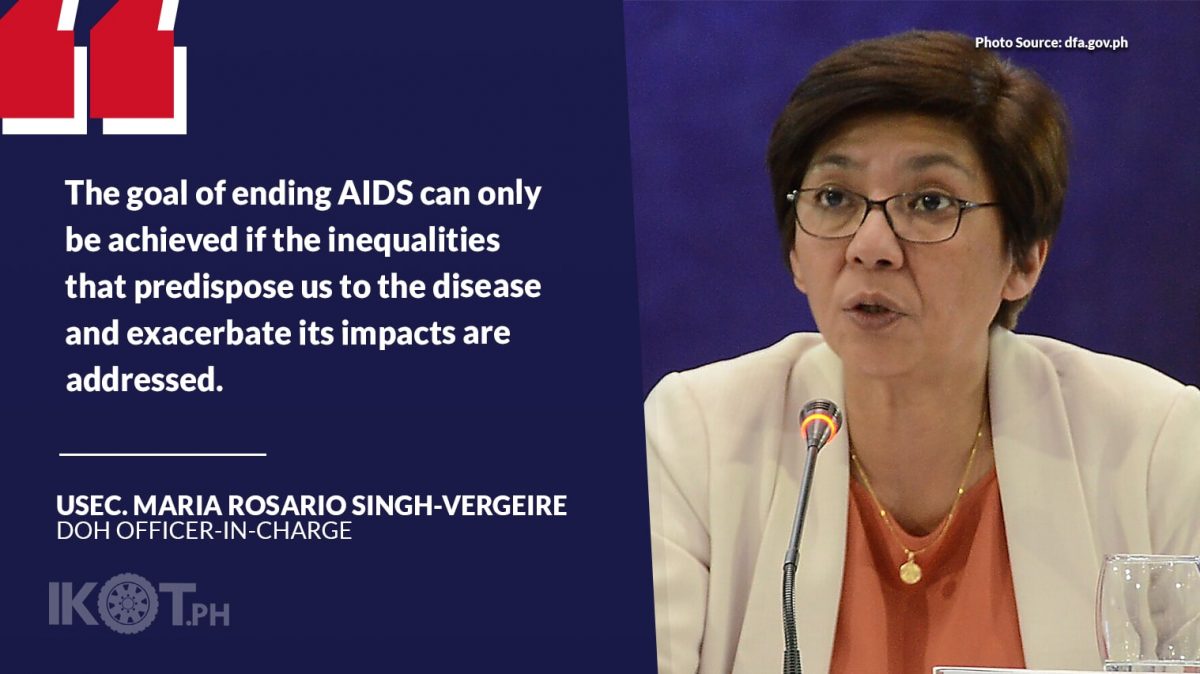In line with the goal to contribute to the global goal of ending AIDS as a public health threat by 2030 and the annual observance of the World AIDS Day, the Department of Health (DOH) launched the 7th AIDS Medium Term Plan (AMTP) and called for equal access to services for People Living with HIV (PLHIV) as well as full protection of human rights.
This year’s World AIDS Day theme “Putting Ourselves to the Test, Achieving Equity to End HIV” called for bold, urgent action to promote rights-based, community-led, and evidence-based HIV services including prevention, sexual and reproductive health services, HIV testing, treatment, care and support.
The celebration also emphasized accountability and action, affirming the country’s participation in the Global AIDS Strategy (2021-2026) that seeks to reduce inequalities by 2025 that drive the AIDS epidemic.
“The ongoing HIV and AIDS epidemic in the country remains to be one of the long-standing issues requiring concerted action from all sectors of society,” said DOH Officer-in-Charge Maria Rosario Singh-Vergeire.
“While the DOH strives to ensure continuous, unhampered provision of health services to all Filipinos, we also require the support of other sectors and stakeholders to cultivate a sustainable and supportive environment that is responsive to the needs of our vulnerable and key populations–such as our PLHIVs. The goal of ending AIDS can only be achieved if the inequalities that predispose us to the disease and exacerbate its impacts are addressed,” Vergeire added.
“In the Asia and Pacific Region, the Philippines has the fastest growing HIV case.”
Globally, UNAIDS disclosed that there were 38.4 million people living with HIV at the end of 2021. In the Asia and Pacific Region, the Philippines has the fastest growing HIV case with a 237% increase in annual new HIV infections from 2010-2021. In the same period, AIDS-related deaths have increased by 315%.
Currently, the latest DOH HIV, AIDS and ART Registry of the Philippines reported that there were 107,177 cases since January 1984.
Moreover, as of October 2022, there were 1,383 newly-diagnosed cases and 65 newly-reported deaths in the country. Majority (96%) of new cases were male. Age of reported cases ranged from 2-75 years old.
Sexual contact remained as the predominant mode of transmission (97%).
According to experts, if the current efforts in HIV response are maintained, the estimated PLHIV in the Philippines could reach 364,000 by 2030, which is a two-fold increase from estimated PLHIV by the end of 2022.
To realize the vision of zero new infection, zero discrimination, and zero AIDS-related death, the DOH emphasized that all stakeholders and partners, including community and civil society organizations, must act holistically–not just looking at health but also addressing its determinants–to end the HIV epidemic.
“Only through collective action will we be able to end the HIV epidemic in the country.”
“We must all work together not just to implement our strategies and interventions, but to ensure that those who need it most–especially our PLHIVs and other key populations–are able to access our HIV services without difficulty or stigma. Beyond this, we must also harness our individual expertise and join our efforts to address the systemic and socioeconomic barriers that prevent our fellow Filipinos from leading healthy, productive lives free from the impacts of HIV. Only through collective action will we be able to end the HIV epidemic in the country,” Vergeire stressed.
“On an individual level, marami rin tayong mga pansariling hakbang na maaaring gawin upang mapigilan ang pagkalat ng HIV. Let us always practice safe sex, regularly undergo HIV testing, and encourage all our friends and peers to do the same,” she added.


